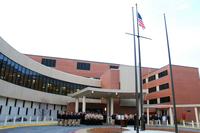America's top four space agencies -- NASA, the NRO, Space and Missile Systems Command and the Missile Defense Agency -- are joining together to improve how they design, buy and build launchers, sensors and satellites.
The memorandum of understanding -- signed so far by the spy satellite builders and operators at NRO and the SMC folks -- will help them "work together to develop and share best practices and lessons learned to take into account the health of the industrial-base, space systems acquisitions and to participate in forums that will improve performance such as the space quality improvement council and the mission assurance improvement workshop," said Wanda Austin, CEO of the Aerospace Corp, which provides federally-funded advice to the Air Force, NRO and other space bodies. Austin spoke to reporters in a hone call with reporters during the U.S. Space Mission Assurance Summit.
The agreement is part of the space enterprise's continuing effort to recover from almost a decade of failed, crippled or just seriously overbudget programs. A senior official at SMC, Doug Loverro, noted this when he said the new agreement would "let us get even better at this while at the same time pursuing the efficiencies we know that DOD is looking for. And, so, I think we are not at the end of the road. We certainly passed the beginning, but we are heading down the same path that we started several years ago in keeping on a track of assuring our space capabilities through our great mission assurance and program assurance process."
One other bit of news arose from that call. The NRO's new charter, in the works for several years now and reportedly close to fruition for some time, isn;'t quite there yet, NRO Director Bruce Carlson said. The Memorandum of Agreement between Defense Secretary Robert Gates and the Director of National Intelligence setting out the parameters of the new charter and the agency's duties and legal responsibilities may be enough for now.
"And, quite frankly, I could live with the MOA. I got about 95 percent of what I wanted in there and, so, we’re executing to that MOA right now, and, in fact, we’re in the process of working an issue that sort of comes out of that and it has to do with launch and how much that we pay for and whatnot versus what the Air Force pays for, and the role of our job inside the launch apparatus in the country and it’s been a fascinating opportunity to use that MOA for real," Carlson said. He said creating the next budget -- not to mention those two wars and the other national intelligence interests going on -- means the charter is "just not actively being worked right now because we simply have too much to do, but we’ll get to it here after the first of the year, I imagine."







